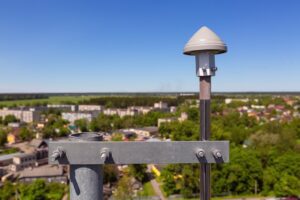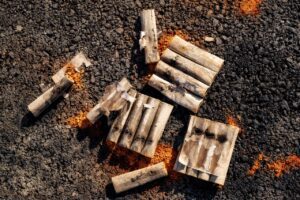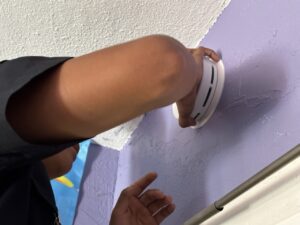[ Updated March 6, 2014 ] During the first nine weeks in Los Angeles, 11 people have died in house fires. In every one of those incidents, not one functional smoke alarm was found. Overall, on average more than 20 people per year have died over the course of the past four years in L.A. And, this year, we’re on track to more than double those numbers. Those are pretty tough statistics, and officials in Los Angeles want the trend to stop. The LAFD is sharing information along with UFLAC, the AIFF, and other agencies to warn people about living in homes without working smoke alarms.
The LAFD is also working with MySafe:LA to distribute smoke alarms to people in need, and to get fast facts (called “15 Minutes of Safety” by the LAFD) into the hands of 5th grade students. In addition, whenever a significant incident occurs in LA, firefighters will canvas the adjacent streets and help get the word out that smoke alarms save lives. Free alarms will be provided to people without them, and who complete a “pledge” to maintain them. MySafe:LA contributed 3,500 smoke alarms to the city via its partnership with First Alert.
Unfortunately, just as cars run red lights and experience collisions, telling people to use a smoke alarm isn’t enough. The efforts put forth by smoke alarm companies and fire agencies such as First Alert, the LAFD, and others, including MySafe:LA are a start, but more needs to be done. It’s a complicated issue, and understanding what others have discovered is a good place to start.
An NFPA study from 2011 demonstrated that the fire fatality rate in homes without smoke alarms is twice as high as those with functional alarms. Other studies put the overall rate at 66 percent. That means that Los Angeles is demonstrating a frightening trend, with more than 90 percent of fatalities occurring in homes without working alarms. At the same time, telephone surveys done by the NFPA in multiple years have indicated that 96 percent of homeowners claim to have at least one working smoke alarm. This has led numerous researchers to doubt the validity of “self reporting” statistics on this topic. A comprehensive study published by InjuryPrevention.BMJ.com in 2012 provided excellent statistics about the validity and reasons behind over-reporting of smoke alarm use.
This doesn’t mean that people are lying, although there are clearly people who think giving a positive answer is “pleasing” and makes them look good. What it does mean without question is that the smoke alarm issue is complex. Poor placement, number of devices required, types of power sources, longevity of power, and the context in which they’re used affects the outcome: people dying in fires where properly placed, properly powered, properly categorized smoke alarms might have saved them.

There are really two issues that are central to the “smoke alarm” issue. The first is getting working alarms into the home and ensuring they’re functional and properly placed. The second is understanding the issues that were in play for those people who did die in fires despite a working alarm. We know the most common reasons for the latter: people, either due to age or disability were not able to hear the alarm when it was triggered by fire.
There are other factors to consider as well. The time it takes for a fire to go from first ignition to “flashover,” when the whole room bursts into flame, has fallen dramatically. This means the window of opportunity to get outside to safety is much smaller than it used to be. In 1980, when smoke alarms really began to find acceptance due to their affordability, a family might have as long as 15 minutes to escape before conditions inside the home became deadly. In those days, the content within the home included wood, metal, glass, and paper. Today, the content in our homes is often plastic and synthetics. These items burn hotter and faster, and contribute to a deadly atmosphere of smoky poisons. Today, researchers estimate the time to escape a home fire safely is approximately three minutes. So, why doesn’t everyone maintain working smoke alarms?

Frankly, many people believe smoke alarms are a pain in the neck. A study done by our friends at Kelton Global revealed that 61 percent of people surveyed have allowed their smoke alarms to remain in place without a working battery. The paradox comes into play when people admit a working alarm is an important element to home safety. A gap analysis conducted by AARP regarding general home safety found 98 percent of all participants (ages 18-49 as well as 50 plus) reported, “a working smoke alarm on every floor is important or very important.”
Multiple studies are revealing that nearly everyone believes a working smoke alarms are important, but not everyone has them. Why not?
It may be that many people don’t understand the issues involved with placement or maintaining them. Worse, there are so many variables in alarms today, and the laws differ from state to state, so focusing in on the key issues is necessary if we’re to close the gap on the residences that remain unprotected – and that means a defined percentage with an alarm in place. It’s just in the wrong spot, doesn’t work, is the wrong kind, or is too old.
Vision 20/20, a collaborative project that brings national fire safety organizations including MySafe:LA together with fire marshals and fire agencies, published an important report on smoke alarms and the resulting complexity of their use in January 2014. The report is a useful tool relative to the issue of smoke alarms and their effectiveness because it combines the outcome of multiple reports and creates a baseline from which fire responder agencies and even the manufacturers of smoke alarms can begin to better identify the most at-risk audiences.
No report, not even from the esteemed Vision 20/20 people, USFA, FEMA, or NFPA can solve the problem. But they can collaboratively share research data that will help us work more effectively on reducing fire fatalities.
MySafe:LA provides free smoke alarms to people in need in Los Angeles. In 2013, our organization provided several thousand free alarms to families in south central and the San Fernando Valley. Already in January of this year, in collaboration with First Alert, we’ve arranged for 3,500 alarms to be provided to the Los Angeles Fire Department for distribution to the public. The MySafe:LA team will deliver thousands more directly to families and older adults.
In our case, we don’t just give them away. We deliver a very successful program for students called the Jr Fire Inspector program. Our instructors go into schools and teach 4th and 5th grade students to inspect their homes for working alarms and other fire dangers. We spend multiple visits (more than 3 hours total) with these eager students in at-risk neighborhoods, provide them with the materials they need, and our school partners treat the process as homework.

After the students have completed their inspections and on request, we provide a free alarm and working batteries. The engagement with the students helps establish a basis upon which installation of the alarms and maintenance of them is encouraged. MySafe:LA is currently in the midst of additional research to determine the status of those alarms a year after they were delivered and will publish results later this year. We’re now delivering a similar program with older adults and we’ll provide not only alarms, but installation support as well. We view this as essential, as older adults (over 55 years of age) are more than twice as likely to die as a result of fire than any other age group.
MySafe:LA recognizes the importance of ensuring alarms are working, are in the right locations, and are the right type. To that end, our new “installation cadre” will work with specific audiences, including church groups, schools, and community associations to ensure these alarms are making a difference – keeping people alive (by notifying them to escape) when they experience a fire in their home.
We’re also working to establish a better understanding of what smoke alarms can do and the benefits of keeping them working. We’re managing a study that will help others use the data we gather to create more awareness and hopefully results.
The first step is a new educational podcast series that will launch this coming week. We’ll teach people about the dangers associated with the lack of an alarm, the technology of alarms, the issues faced by people who are young or old, disability issues, and much more. We’re also producing new video and web content to help people take action to help themselves as part of our new “Fire Burns – Smoke Kills” smoke alarm campaign. The questions related to why people are dying in fires and the impact smoke alarms have must be answered. And the answer starts with you – if you live in a building of any type, you are doing yourself and your family a favor by ensuring you have working smoke alarms.







